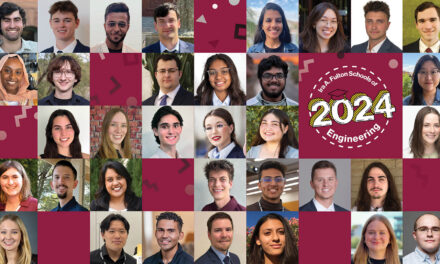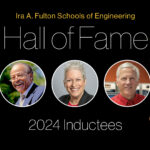
Young students make the engineering connection
January 25, 2010
More than 40 eighth-graders stepped into the spotlight at the Arizona Science Center recently as the finale to a nearly year-long collaboration with Arizona State University’s Ira A. Fulton Schools of Engineering.
They represented more than 125 students from Santan Junior High School in Chandler, Ariz., who participated in Partnership, Pathway and Pipeline for Engineering Education – called P3E2 for short.
The pilot program supported by the National Science Foundation enabled students to get a hands-on introduction to the practice of engineering.
At the Science Center, students unveiled posters and displays exhibiting details of dozens of team projects that employed math, science and engineering skills to solve problems.
“Their first step was to look at things in their homes or schools, or around their communities, that could be improved or fixed with engineering solutions,” said B. Ramakrishna, an associate professor of materials science and engineering at ASU, who coordinated P3E2.
Students had guidance from leaders and faculty members of ASU’s engineering schools – including Ira A. Fulton Schools of Engineering Dean Deirdre Meldrum – as well as about a dozen ASU students from the School of Mechanical, Aerospace, Chemical and Materials Engineering, and the School of Biological and Health Systems Engineering.
Santan Junior High School assembled a P3E2 support team from Chandler Unified School District staff members and teachers, including Melissa Stanley (math), Robin Flyte (science), Sarah Segal (language arts) and Amy Drake (social science), along with a guidance counselor and an instructional specialist.
Grouped into teams of three to four students each, the youngsters embarked on a wide range of projects.
They took on such challenges as finding ways to use insulation to save energy, to improve popcorn popping, to remove rust from nails, to devise faster ways to cool drinks and more efficient ways to freeze or melt chocolate.
Some delved into product testing and cost analysis. Others designed a bobby-pin dispenser, built models for bridges and dams, worked on solar-energy applications, designed rocket fins, and studied the effect of using colored water on flowers.
More important than the results were the lessons learned by doing the projects, Ramakrishna said.
“It gets across the message that engineering is a helping profession, like medicine or law,” he said. “We tried to make students see the connection between math and science and engineering and the things that help society and provide ways to fix problems in their own communities.”
The program has motivated students and teachers at Santan, said school principal Barbara Kowalinski.
It has made young students aware of the diverse applications of engineering, and the many academic and career options offered by studies in science, math and technology.
Kowalinski said the program also helped teachers recognize the value – and the challenges – of integrating engineering concepts into middle school curriculum.
Ramakrishna’s P3E2 group at ASU included bioengineering associate professor Vincent Pizziconi; materials science and engineering professor Stephen Krause; Lynn Cozort, one of the engineering schools’ directors of graduate studies; assistant professor of education Tirupalavanam Ganesh; and Susan Haag, associate research professional with the Center for Research on Education in Science, Mathematics and Technology.
Ramakrishna and other ASU colleagues also have coordinated a National Science Foundation program for the past decade that sends ASU graduate students to local K-12 schools in the greater Phoenix area to assist teachers with integrating engineering and science studies into their classes.
Watch a video of students in the P3E2 group during their project exhibit event at the Arizona Science Center.



































